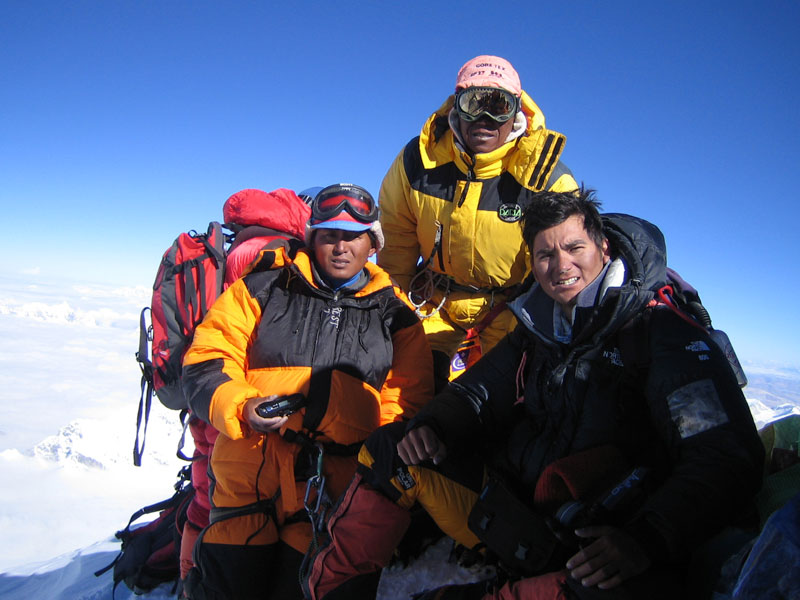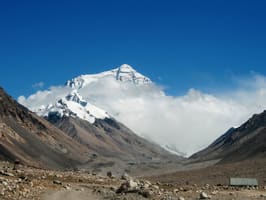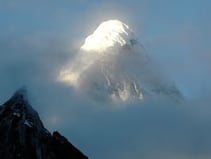Mount Kanchenjunga
Kanchenjunga is also known under similarly-spelled names, such as Kangchenjunga or Kinchinjunga. Situated within the Great Himalayan Range, it is the world’s third highest peak. The peak’s massif consists of four summits, three of which are over 8,000 metres high. Kanchenjunga I is the highest, at 8,586 metres. Kanchenjunga West takes the second place at 8,505 metres. Next is Kanchenjunga South – 8494 metres. Finally, the lowest one is Kangbachen 7,903 metres. The summits’ location resembles a cross, with each summit signifying one arm. There are four main ridges connecting the summits to adjacent peaks. Kanchenjunga’s ridges are rich in glaciers.
Once assumed to be the highest mountain in the world, Kanchenjunga, meaning ‘five treasures of the high snow’ is located between Nepal and India. This magnificent mountain was first climbed in 1955 by Joe Brown and George Band of the British Kanchenjunga Expedition– 50 years after the first expedition made an attempt in climbing Kanchenjunga in 1905.
Mythical beliefs about Mount Kanchenjunga
The inhabitants of the surrounding Indian and Nepal regions recount seeing a mysterious creature roaming the slopes of Kanchenjunga. In 1925, a British expedition sighted a bipedal figure, which the locals described as the mountain’s demon. Local people believe that the mountain is a place where gods dwell.
The story of the valley of immortality is another commonly known legend associated with the mountain. Known as Beyul Demoshong in Tibetan, it is believed to be hidden somewhere in Kanchenjunga’s snowy slopes.
Climbing Kanchenjunga
The base camp trek
As the most remote 8,000 metre mountain, the approach on the Kanchenjunga expedition takes you to the eastern border of Nepal, trekking through unspoiled and remote areas in the Arun valley before arriving at the base camp. The trek to base camp leads through one of Nepal’s most beautiful routes, including the Kanchenjunga Conservation Area. The Area is rich in various vegetation forms, from cultivated lands to lush forests. It is also home to such magnificent animals as the snow leopard or the red panda. The Conservation Area is part of the Sacred Himalayan Landscape.
For specific information about the expedition’s proceedings, see the detailed itinerary below.
Technical characteristics of the expedition
Climbing Kanchenjunga is intricate mixed climbing at first and then later involves one of the longest horizontal climbs above 8,000 metres, making it a very demanding mountain that requires well planned logistics and a good, strong support. Probably that is why, despite being the 3rd highest mountain in the world, Kanchenjunga sees very little traffic.
The expedition lasts nearly ten weeks, so you should take into account the changing weather conditions. Before the final departure, make sure to be prepared for snowstorms, as during the summer monsoon season there is heavy snowfall. In the winter, the snowfall is less burdensome. Nevertheless, the weather at Kanchenjunga can be quite unpredictable.
The Kanchenjunga ascent is a tricky one – you need to be prepared for the risk of falling ice or avalanche. Apart from the weather dangers, the air is extremely thin at such high altitudes, which further obstructs the climb. It is imperative to have a reliable, professional support in such harsh conditions.
What you get from Asian Trekking
Focus on your preparation, fitness, and motivation, letting us take care of the rest. Asian Trekking handles the logistic aspects of your expedition, devising a meticulous plan of the journey. Your safety is our main concern, so we make sure to provide you with the best support. It starts before you even set foot on the route, when you receive an expedition briefing. When you head out, you will be accompanied by the finest guides – climbing Sherpas. These seasoned locals know the conditions of the area and the routes from A to Z. Their assistance and knowledge is invaluable during the ascent.
Who can climb Kanchenjunga?
Advanced technical skill level is a must to take part in the Kanchenjunga Expedition. It is regarded by some as a more difficult ascent than Mount Everest. You need to have substantial mountaineering experience to be able to attempt the ascent, due to harsh terrain and weather conditions. The expedition includes treks and climbs lasting over 10 hours per day, hence, excellent physical condition and is required. Winter technical climbing gear is absolutely necessary.
Why climb Kanchenjunga?
- World’s third highest peak at 8,586 metres
- A major challenge for experienced mountaineers
- Stunning nature, including the panorama of the Himalayas and Kanchenjunga Conservation Area
- Excellent trip organization and the most qualified mountain guides provided by Asian Trekking
To get information and advice about the expedition, click the “Ask for details” button in the top left corner. You can either fill in a contact form or write to our travel experts directly. We will be happy to help!
Skydiving in Nepal – check this out!
Good To Know
Asian Trekking is a Nepali expedition operating company established 36 years ago. According to Paragraph 26 of the Tourism Act (2035), no foreign expedition teams or companies are allowed to provide expedition services in Nepal directly and any foreign company must work through a Nepali company licensed by the Ministry of Culture, Tourism and Civil Aviation, Government of Nepal. As such, Nepali companies are the ones that provide all the legal, administrative, logistical, guiding and support services in Nepal, while also being legally responsible for the safe and responsible conduct of the expeditions. Booking through foreign expedition companies naturally makes the cost to the customer higher due to the extra layer of administration and profit margins, without necessarily adding any extra value.

















